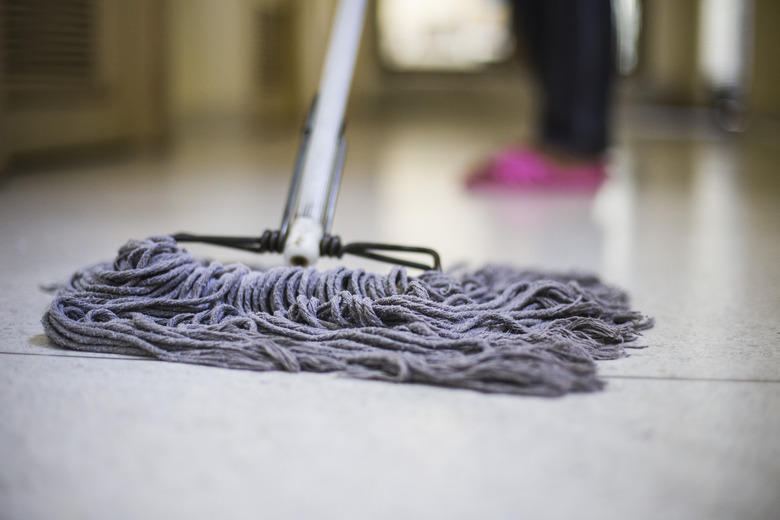How To Dry The Floor After Mopping
We may receive a commission on purchases made from links.
Drying a floor after mopping prevents streaks and water spots as well as water damage on vulnerable flooring materials, such as cork and hardwood floors, which can absorb moisture due to them being porous. Water left on floors can seep into the cracks and seams or around the perimeter of the room, which can cause substrate swelling, adhesive bond failure, or warping and twisting of wood. It can also cause mold, mildew, and wood rot to the substrate and support structure beneath the floor.
Things Needed
-
Towel
-
Rags
-
Oscillating fan
-
Dry mop
-
Rubber bands
How to Dry Floors
1. Dry With a String Mop
Position a dry string mop on the floor at the entrance of the room. Move the mop back and forth, working across the floor and toward the opposite wall, turning the mop frequently to avoid water saturation of the mop strings. Continue to move methodically from one side of the room to the other while heading toward the opposite wall until there is no moisture on the floor.
2. Dry With a Towel
Fold a thick, absorbent towel into a large square or rectangle. Kneel on the floor at the entryway. Press on the towel and move it from side to side across the room. Continue to wipe the floor with the towel while heading toward the far wall until no water remains on the floor.
3. Use a Squeegee
Attach a squeegee to a long mop handle. Stand at the entrance to the room. Extend the squeegee into the room directly in front of you. Lower the squeegee to the floor and pull it toward yourself. Lift the squeegee and wipe the edge with a rag to dry accumulated water. Bend down and dry the floor with a rag at the point at which you lifted the squeegee from the floor. Continue to extend the squeegee over wet parts of the floor, pulling it back and wiping the squeegee and floor until the entire floor is dry. As you dry paths on the floor, step onto dry areas so you can reach the wet areas.
4. Dry the Floor With a Fan
Set up a large oscillating fan on a dry section of the floor. Angle the fan toward the wet floor. Turn the fan on and allow the airflow to dry the floor. This process goes faster if you have multiple fans blowing from different directions.
5. Use a Dry Mop
Wrap the head of a dry, clean mop with an absorbent rag. Place one large rubber band over the rag and around the dry mop's head on each side of the dry mop head. Move the rag to cover the rubber bands, hiding them in the folds of the rag. Begin at the entrance of the room and move the rag-covered dry mop back and forth across the floor while moving toward the distant wall. Remove, refold, and reattach the rag when it no longer absorbs water from the floor. Continue to move about the room until the floor is dry.
Tip
Always begin at the entrance of the room where the floor is dry to prevent leaving footprints on the wet floor.
Warning
Wet floors are slippery; avoid walking on them until they're dry. Don't plug in an electric fan while standing on a wet floor. Don't place an electric fan on a wet surface.
